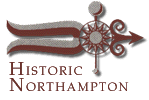
Bridge Street Cemetery Northampton Architecture Historic Markers 
|


The Abolition Era: Industry & Anti-Slavery
 |
 |
 |
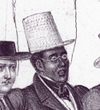 |
 |
Josiah White's Oil Mill |
Silk & Mulberry Trees |
Beet Sugar Experiment |
Water Cure & Hydropathy |
The Florence Compound |
This historic marker recognizes the burgeoning manufacturing village of antebellum Florence forged by its abolitionist & African-American residents. |
Sponsored by Florence Savings Bank and MassHumanities |
Josiah White's Oil Mill
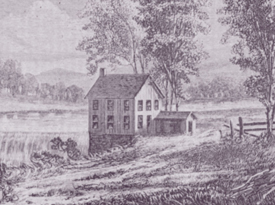 |
Josiah White's Oil Mill drawn by Charles C. Burleigh, Jr. |
The exposed granite ledges at the Nonotuck Silk Company dam tell the story. Here, Mill River rapids drop 28 feet to allow for a durable water power. The first enterprise in Broughton’s Meadow, a sawmill, was established as early as 1681. In 1807, Josiah White built a mill to express linseed oil from neighboring farmers’ flax seed. He added a grist mill in the same building and maintained the saw mill across the river. In 1835, White’s son-in-law sold the entire property to Samuel Whitmarsh who installed modern silk manufacturing equipment in White’s old mill.
Whitmarsh’s enthusiasm for silk production was infectious. He accumulated over 400 acres, rounded up New York investors, and set growing thousands of mulberry trees, the food of the silkworm. By 1837 he built a new four-story factory downstream. Then, the bottom fell out of an inflated market in mulberry trees, taking his Northampton Silk Company with it. The remaining stockholders hired Joseph Conant of Mansfield, Connecticut to run the mill and arrange for renters while they looked for a buyer. In 1840 he leased the Josiah White cottage to David Lee Child, rented him twenty acres of farm land and arranged for the Boston abolitionist to put his beet sugar-making equipment in the mill.
The Northampton Association of Education and Industry
 |
Silk factory & community boardinghouse of the Northampton Association |
With the Northampton Silk Company for sale at a fraction of its value, abolitionist refugees from northeastern Connecticut — among them George W. Benson (William Lloyd Garrison’s brother-in-law) and Samuel L. Hill (related to Conant through marriage) — purchased the property. In 1842, they and other abolitionists founded the Northampton Association of Education and Industry. They set out to run the company cooperatively, sharing its fruits as one community. Here they would stand against slavery and exploitative business practices. Men and women had equal voting rights and pay, as did African Americans and, specifically, self-emancipated slaves. At its peak, 120 people lived and worked together midway through its four-and-a-half year existence. Garrison spent a summer here where his children attended the community school. Sojourner Truth joined in 1844, giving her first anti-slavery speech in Northampton and going on to become one of the country’s greatest workers against slavery and for women’s rights. Frederick Douglass, once a David Ruggles assisted fugitive, first met Truth here during one of his occasional visits.
David Lee Child and the Sugar Beet Operation
 |
David Lee Child |
When David Lee Child arrived in Northampton with his wife, the famous writer Lydia Maria Child, he was determined to compete with producers of slave-grown sugar cane. Only two years earlier their plans to join Benjamin Lundy at a Free Produce commune in Mexico fell through when Texans defeated the Mexican army. David traveled to Europe in 1836 to learn how to manufacture beet sugar. Having heard that the Connecticut River Valley was the best place for his experiment, the couple moved to Northampton. In 1839, David won an award for the first beet sugar produced in America and the couple decided to expand operations on 100 acres of land in Lonetown, now Florence. The sugar-making equipment was installed in the old oil mill. They rented a cottage across from the mill since the “shantee” on their own property was in disrepair.
By spring of 1841, never having produced a significant quantity of sugar, financial insecurity drove Maria to accept the position of editor at the National Anti-Slavery Standard in New York City. David remained, declared bankruptcy in 1842 and commenced peat production on the swampy land they had bought. That project failed as well and the Childs moved away permanently in 1849, finally settling in Wayland in eastern Massachusetts.
Silk, Cotton, Plastic & Hydropathy
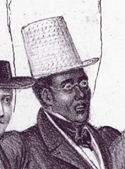 |
David Ruggles |
The Association broke up in 1846. The evangelical abolitionist J. P. Williston and his partners had already purchased the silk mill, converting it to cotton production. Their Bensonville (later Greenville) Manufacturing Company hired fugitive slaves, providing homesites for those who cared to settle here. Basil Dorsey, teamster for the company, escaped slavery in 1836, moving to Florence in 1844. His second house is near the dam at 4 Florence Road. New York Underground Railroad hero David Ruggles, broken down in health, joined the Northamtpon Association in 1842 and treated himself using hydropathic methods. He established the Northampton Watercure by 1847 and is thought to have continued assisting fugitive slaves.
Samuel L. Hill, founder of the Nonotuck Silk Company, assisted fugitive movement from his house on Maple Street. Starting in 1854, Alfred P. Critchlow, inventor of an early plastic known as the“Florence Compound,” manufactured union cases for daguerreotypes in a factory behind the silk company. In the one recorded case of a slavecatcher coming to Florence, Critchlow sheltered a man known to us only as French. Because of all this activity Florence came to be ten percent African-American by 1850, the year the federal census was taken locally, just one month before the Fugitive Slave Law was enacted.
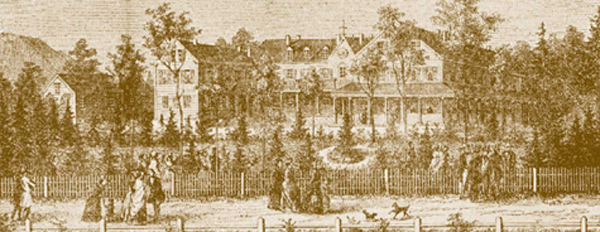 |
Contents Historic Northampton.
